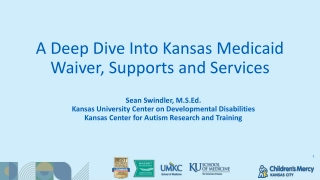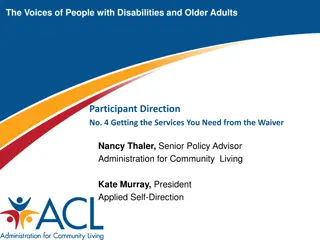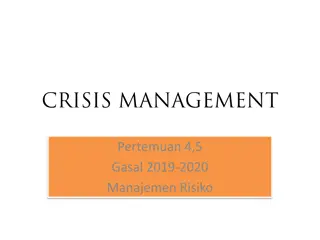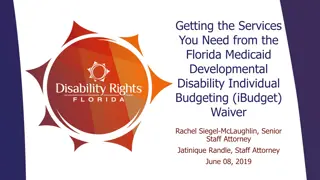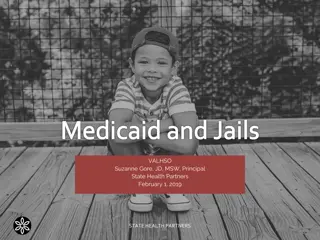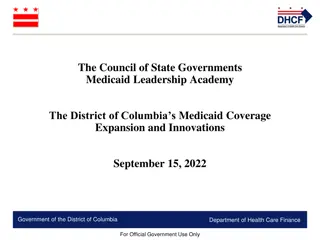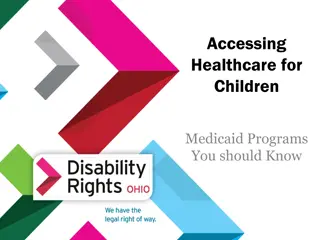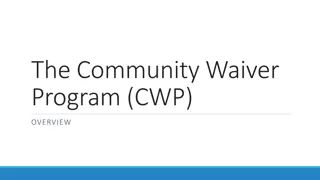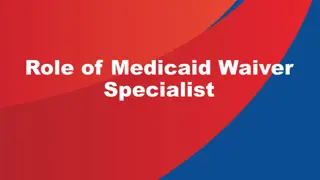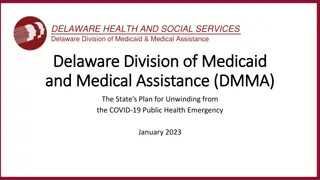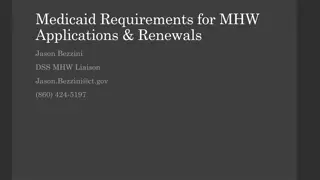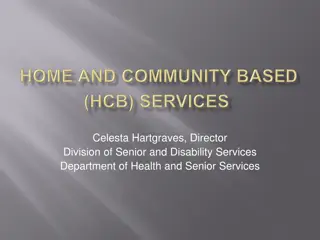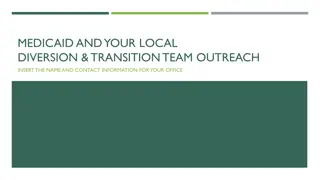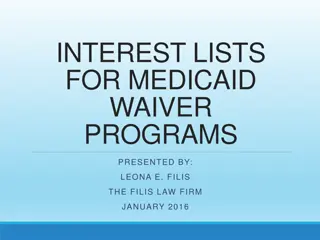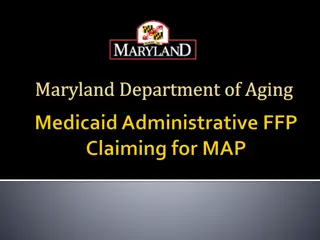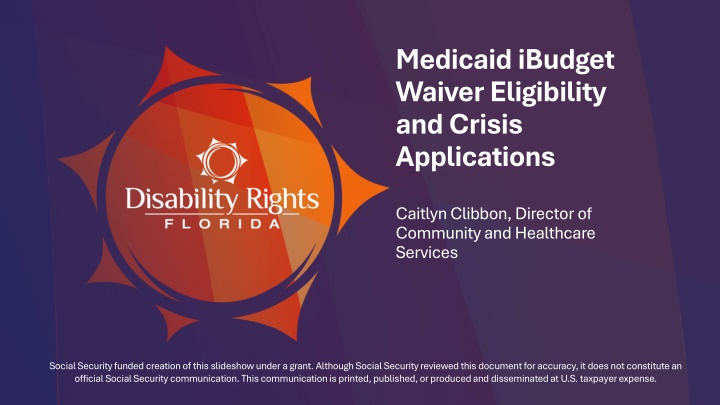
Medicaid iBudget Waiver: Eligibility & Crisis Applications
Caitlyn Clibbon, Director of Community and Healthcare Services, discusses iBudget Waiver eligibility criteria, documentation submission, crisis eligibility, and application process. Learn about Disability Rights Florida's mission and learning objectives.
Download Presentation

Please find below an Image/Link to download the presentation.
The content on the website is provided AS IS for your information and personal use only. It may not be sold, licensed, or shared on other websites without obtaining consent from the author. If you encounter any issues during the download, it is possible that the publisher has removed the file from their server.
You are allowed to download the files provided on this website for personal or commercial use, subject to the condition that they are used lawfully. All files are the property of their respective owners.
The content on the website is provided AS IS for your information and personal use only. It may not be sold, licensed, or shared on other websites without obtaining consent from the author.
E N D
Presentation Transcript
Medicaid iBudget Waiver Eligibility and Crisis Applications Caitlyn Clibbon, Director of Community and Healthcare Services Social Security funded creation of this slideshow under a grant. Although Social Security reviewed this document for accuracy, it does not constitute an official Social Security communication. This communication is printed, published, or produced and disseminated at U.S. taxpayer expense.
Caption Options & ASL Closed Captions: CC button at the bottom of the screen External Caption Viewer: Link provided in the chat ASL Interpreters: Spotlighted on your screen 3
Submitting Questions & Recording Q and A button: Located at the bottom of the screen oEmail: Webinar@DisabilityRightsFlorida.org You can submit questions at any time. We will answer them throughout the webinar. Please try to limit sharing your personal information in the chat or questions. You can reach out to our Agency if you have more specific questions related to your Fair Hearing. This webinar will be recorded and posted on our website and YouTube channel. 4
Disability Rights Florida Funding, responsibility, and authority under nine federal programs to protect the rights of Floridians with disabilities. A not-for-profit corporation since 1987. Offices in Tallahassee, Tampa, Gainesville and Fort Lauderdale. 6
Our Mission Disability Rights Florida advocates, educates, investigates, and litigates to protect and advance the rights, dignity, equal opportunities, self-determination, and choices for all people with disabilities. 7
Learning Objectives Today, you will learn about: iBudget Waiver Eligibility Criteria Submitting Documentation for iBudget Waiver Eligibility How to Submit Your Waiver Eligibility Application and Deadlines Crisis Eligibility Criteria Types of Documentation to Submit for Crisis Eligibility How to Submit Your Crisis Application Note: We can t advise on specific cases today. Please don t put personal information into the chat. Please contact our intake department if you want to request individual assistance. Contact info will be provided at the end. 8
iBudget Waiver Eligibility Basic Criteria Basic Criteria Be eligible for Medicaid under any category Meet the Level of Care criteria for ICF/IDD placement Be diagnosed with one or more qualifying disabilities. Meet the eligibility requirements set forth under Ch. 393, Fla. Stat. 10
iBudget Waiver Eligibility Medicaid (1 of 2) The following groups are eligible, assuming they meet income and asset limits: Low-income families with children Pregnant women Children in foster care and certain children adopted from foster care Social Security Income Recipients Low-income seniors age 65 or older Low-income people who are Blind or have a qualifying disability Low-income people who need hospice or institutional care 11
iBudget Waiver Eligibility Medicaid (2 of 2) For the iBudget Waiver, applicants are considered a household of one . Family income, even if the applicant resides with family, is not considered. Medicaid eligibility must be established within one year of notice of iBudget waiver eligibility or else you will have to re-apply. 12
iBudget Waiver Eligibility Level of Care Determination made by APD. Agency documents major life activities and handicapping conditions to determine LOC. Major Life Activities: Self-Care Understanding and Use of Language Learning Mobility Self-Direction Capacity for Independent Living Categories of deficits considered: Ambulatory Sensory Chronic Health Behavior 13
iBudget Waiver Eligibility Qualifying Disabilities Qualifying Disabilities for iBudget Waiver Eligibility: Autism Cerebral Palsy Intellectual Disability Prader-Willi Syndrome Spina Bifida Down Syndrome Phelan McDermid Syndrome **Children between 3 and 5 years of age at high risk of later diagnosis of one of the above listed disabilities 14
iBudget Waiver Eligibility Ch. 393 Definitions Each qualifying diagnosis is defined in Ch. 393.063, Fla. Stat. Agency Authority Ch. 393 delegates authority to APD create rules about eligibility procedures and criteria, as long as they comply with the statutes and other applicable state and federal law. Agency Rules 65G-4.014: Provides further definition of each qualifying diagnosis and, for some diagnoses, factors that must be met to prove the qualifying diagnosis. 65G-4.017: Lays out who must make the diagnosis. 15
Autism Category (1 of 3) Ch. 393: Autism means a pervasive, neurologically based developmental disability of extended duration which causes severe learning, communication, and behavior disorders with age of onset during infancy or childhood. Individuals with autism exhibit impairment in reciprocal social interaction, impairment in verbal and nonverbal communication and imaginative ability, and a markedly restricted repertoire of activities and interests. 16
Autism Category (2 of 3) Rule 65G-4.014: Pervasive: always present and without interruption. Neurologically based: not the result of physical impairment. Extended duration: condition reasonably can be expected to continue indefinitely into the future. Causes severe learning disorders resulting in both (1) severe communication disorders affecting both verbal and nonverbal skills, and (2) severe behavioral disorders. This is proven through meeting 6 of 12 factors laid out in the rule. The factors are broken into two parts and at least one factor from part 2 must be met. 17
Autism Category (3 of 3) Rule 65G-4.014: Diagnosis must be made by: A Florida-licensed psychiatrist; A Florida-licensed psychologist; A board-certified pediatric neurologist who is qualified by training and experience to make a diagnosis of autism; A board-certified developmental pediatrician, or Collateral information received from another state may be accepted if the evaluator is licensed through the same credentials required for licensure in Florida for the professions listed in paragraph (1)(a), above. 18
Autism Factors (1 of 3) Part 1: Severe communication disorders A delay in, or total lack of, the development of spoken language (not accompanied by an attempt to compensate through alternative modes of communication such as gesture or mime), Stereotyped and repetitive use of language or idiosyncratic language, For those applicants with speech, marked impairment in the use of multiple nonverbal behaviors such as eye-to-eye gaze, facial expression, body postures, and gestures to regulate social interaction, Failure to develop peer relationships appropriate to developmental level, 19
Autism Factors (2 of 3) Part 1: Severe communication disorders (cont.) A lack of spontaneous seeking to share enjoyment, interests, or achievements with other people (e.g., by a lack of showing, bringing, pointing out objects of interest, or achievements to others), Lack of social or emotional reciprocity, Marked impairment in the ability to initiate or sustain a conversation with others in individuals with adequate speech, or Impaired imaginative ability evidenced by a lack of varied, spontaneous make- believe play or social imitative play appropriate to developmental level. 20
Autism Factors (3 of 3) Part 2: Severe behavior disorders (restricted, repetitive and stereotyped patterns of behavior, interests, and activities) Encompassing preoccupation with one or more stereotyped and restricted patterns of interest that is abnormal either in intensity or focus, Apparently inflexible adherence to specific, nonfunctional routines or rituals, Stereotyped and repetitive motor mannerisms (e.g., hand or finger flapping or twisting, or complex whole-body movements), or Persistent preoccupation with parts of objects. 21
Intellectual Disability Category (1 of 3) Ch. 393: Intellectual disability means significantly subaverage general intellectual functioning existing concurrently with deficits in adaptive behavior which manifests before the age of 18 and can reasonably be expected to continue indefinitely. Adaptive behavior means the effectiveness or degree with which an individual meets the standards of personal independence and social responsibility expected of his or her age, cultural group, and community. Significantly subaverage general intellectual functioning means performance that is two or more standard deviations from the mean score on a standardized intelligence test specified in the rules of the agency. This is generally a Full Scale IQ of 70 or below. 22
Intellectual Disability Category (2 of 3) Rule 65G-4.014: Deficits in adaptive functioning must be in one or more of the following areas: Communication skills, Self-care, home living, Social and interpersonal skills, Use of community resources and self-direction, Functional academic skills, Work, leisure, health and safety awareness and skills. These deficits must constitute a substantial handicap which is reasonably expected to continue indefinitely. 23
Intellectual Disability Category (3 of 3) Rule 65G-4.014: Performance measures must be: Validated by the professional judgment of a psychologist who is experienced in working with people who have retardation, who has specific training and validation in the assessment instrument that is used, and who is one of the following: A Florida-licensed psychologist, A Florida-licensed school psychologist, A certified school psychologist. 24
Cerebral Palsy Category (1 of 2) Cerebral Palsy: Means a group of disabling symptoms of extended duration that result from damage to the developing brain during the prenatal period and characterized by paralysis, spasticity, or abnormal control of movement or posture, such as poor coordination or lack of balance, which is manifest prior to three years of age. For purposes of the rule, cerebral palsy also means the presence of other significant motor dysfunction appearing prior to age 18 due to perinatal or external events such as anoxia, oxygen deprivation, or traumatic brain injury. Excluded from this definition is motor dysfunction caused by medical events, including stroke or progressive diseases such as muscular dystrophy. The impairment from cerebral palsy must constitute a substantial handicap which is reasonably expected to continue indefinitely. 25
Cerebral Palsy Category (2 of 2) Rule 65G-4.014: Diagnosis must be confirmed by written documentation from one or more of the following: A medical doctor; A doctor of osteopathy, or Medical records documenting a diagnosis of cerebral palsy before the age of 18. 26
Prader-Willi Syndrome Category (1 of 3) Ch. 393: Prader-Willi syndrome means an inherited condition typified by neonatal hypotonia with failure to thrive, hyperphagia or an excessive drive to eat which leads to obesity usually at 18 to 36 months of age, mild to moderate intellectual disability, hypogonadism, short stature, mild facial dysmorphism, and a characteristic neurobehavior. 27
Prader-Willi Syndrome Category (2 of 3) Rule 65G-4: A genetic disorder which is most often associated with a random deletion of chromosome 15. Commonly associated characteristics include insatiable appetite, chronic overeating, hypotonia, short stature, obesity, and behavioral issues. Individuals diagnosed with Prader-Willi syndrome generally have mental retardation; however, an individual with Prader-Willi syndrome can be determined as eligible for services without an accompanying diagnosis of mental retardation. 28
Prader-Willi Syndrome Category (3 of 3) Rule 65G-4: Diagnosis is confirmed by written documentation from one or more of the following: A medical doctor; A doctor of osteopathy, or Medical records that document a diagnosis of Prader-Willi syndrome before the age of 18. 29
Spina Bifida Category Ch. 393 and 65G-4: Means a confirmed diagnosis of spina bifida cystica or myelomeningocele. Diagnosis is confirmed by written documentation from one or more of the following: A medical doctor; A doctor of osteopathy, or Medical records that document a diagnosis of spina bifida or myelomeningocele before the age of 18. 30
Down Syndrome Category Ch. 393 and Rule 65G-4: Means a disorder caused by the presence of an extra chromosome 21. Rule adds that it is often associated with impairment in cognitive ability, characteristic physical growth and features, and congenital medical conditions. Diagnosis is confirmed by medical records documenting a chromosome analysis (also referred to as a karyotype) finding the individual has an extra genetic material on their number 21 chromosome. 31
Phelan-McDermid Syndrome Category Ch. 393: Means a disorder caused by the loss of the terminal segment of the long arm of chromosome 22, which occurs near the end of the chromosome at a location designated q13.3, typically leading to developmental delay, intellectual disability, dolicocephaly, hypotonia, or absent or delayed speech. Rule 65G-4: Diagnosis must be confirmed utilizing genetic testing, with written documentation from a: Medical doctor, or Doctor of osteopathy. 32
High Risk Category (1 of 3) Ch. 393: Means a child from 3 to 5 years of age with one or ore of the following characteristics: A developmental delay in cognition, language, or physical development. A child surviving a catastrophic infectious or traumatic illness known to be associated with developmental delay, when funds are specifically appropriated. A child with a parent or guardian with developmental disabilities who requires assistance in meeting the child s developmental needs. A child who has a physical or genetic anomaly associated with developmental disability. Rule 65G-4: Children between 3 and 5 years of age who are at high risk of later diagnosis of one of the 7 disabilities previously discussed. 33
High Risk Category (2 of 3) Rule 65G-4: Requires a determination by an APD area office that a medical diagnosis of developmental delay evidenced by the child indicates a high probability that the child is likely to have an eventual diagnosis of a qualifying condition under Rule 65G-4.014, F.A.C., if early intervention services are not provided, or the child has one or more physical or genetic anomalies associated with a developmental disability and that has been documented by a physician or has a parent or guardian with developmental disabilities who requires assistance in meeting the child s developmental needs. 34
High Risk Category (3 of 3) Children approved under this category are not placed on a pre-enrollment category for waiver services until a confirmed diagnosis of a qualifying disability is given. Despite this, they are eligible for some services. Ch. 393.064 mandates APD provide services to these children and their families but does not mandate specific services or amounts. Per agency memo, the agency provides the following services under this category: Individual evaluations or assessments for diagnosis of I/DD Early intervention services Respite care Support services such as parent education and training, homemaker services, etc. 35
Supporting Documentation Depends on which category you are applying for. Can apply under multiple categories at once. Look to the rule for the specified type of medical professional required for diagnosis, if any. If your documents refer to other documents, you will likely need to provide those as well. Example: IEP refers to psychoeducational evaluation. If not submitted with application and IEP, APD will request the psychoeducational evaluation and it may delay your determination. General examples: IEPs, psychological, psychiatric, or other relevant evaluations, ABA and other therapy records, medical records, etc. Hearing Preparation: Witnesses and Documents Webinar by DRF 37
How to Submit Your Waiver Eligibility Application and Deadlines 38
How to Submit your Application Two options: Online or Via Mail/Fax Online: https://applynow.apd.myflorida.com Will be asked to create an account. You can submit applications on behalf of others. You can save your progress and do not have to complete it in one session. Allows you to submit your documents with the application. **There is no separate application for crisis applications. Via Mail/Fax: Printable PDF available online. Must be mailed or faxed to your regional office. Both the PDF and map to find your regional office can be found here: https://apd.myflorida.com/customers/application/ 39
Application Deadlines Immediate confirmation of receipt of application. Determination must be made within 60 days of a complete application being submitted. *For children in or transitioning out of the foster care system, determination must be made as soon as practicable after receipt of a complete application. Complete application means an applications that is (1) signed and dated by the applicant or with legal authority, (2) is responsive on all parts of the application, and (3) contains documentation of a diagnosis. 40
Other Application Details They agency may toll the time to make a determination if: It needs additional information to make a determination, or If a comprehensive assessment is needed to definitively identify individual conditions or needs. The agency is required to provide this comprehensive assessment. Because of this, it is important to submit all your documentation with the application, if possible. 41
Crisis Eligibility Criteria (1 of 3) Rule 65G-1.047 Category 1: currently homeless, living in a homeless shelter, or living with relatives in an unsafe environment. Relevant Criteria: Without immediate provision of waiver services, the health and safety of the applicant are at risk; Applicant has no shelter available and needs emergency placement by the state; Alternative funding is not available for other placement and services to the applicant; Temporarily staying with friends or relatives but residence is not expected to last more than several weeks; Caregiver has no legal obligation to provide shelter and caregiver s commitment is low; Applicant safety in current setting: risk of physical abuse of the applicant or risk of insufficient supervision and support; 43
Crisis Category 1 Criteria Cont. Relevant Criteria: Home has insufficient room to shelter applicant, or applicant must share a room in an inappropriate living arrangement, based on the ages, genders, and conditions of the persons sharing the room; Applicant s desire for placement creates a reasonable expectation they will be cooperative with placement; Violence or illegal activities within the applicant s current living environment (by applicant or others) has required intervention of law enforcement authorities; Complaints of neglect, exploitation, or abuse of the applicant to Protective Services, or other adverse environmental conditions affecting the applicant, have been investigated and confirmed; The applicant requires services of greater intensity. 44
Crisis Eligibility Criteria (2 of 3) Category 2: Applicant exhibits behaviors that, without provision of immediate waiver services, may create a life-threatening situation for the applicant or others, or that may result in bodily harm to the applicant or others requiring emergency medical care from a physician. Relevant Criteria: Without immediate waiver services, the health and safety of the applicant or others in the household is at risk; Applicant s injury to self or others is frequent or intense; Applicant or others are at risk for serious injury or permanent damage; There is documentation of medical treatment for the applicant s injury to self or others; No other supports are available to address applicant s behaviors; Other attempted behavioral assessments and interventions have proven ineffective; 45
Crisis Category 2 Criteria Cont. Relevant Criteria: The relative ages, sexes, and sizes of the aggressor and the subjects of aggression place the subjects of aggression at risk of injury; Caregiver has insufficient ability to control the applicant; The ages or disabilities of the applicant or caregiver exacerbate the problems; Violence or illegal activity within the applicant s current living environment by the applicant or others has required the intervention of local or state law enforcement authorities; Complaints of neglect, exploitation, or abuse of the applicant, or other adverse environmental conditions affecting the applicant have been investigated by Protective Services and confirmed pursuant to Chapter 39, Part II, or Section 415.104, F.S.; The applicant requires services of greater intensity. 46
Crisis Eligibility Criteria (3 of 3) Category 3: The applicant s current caregiver is in extreme duress and is no longer able to provide for the applicant s health and safety because of illness, injury, or advanced age. The applicant needs immediate waiver services to remain living with the caregiver or to relocate to an alternative living arrangement. Relevant Criteria: Without immediate provision of waiver services, the applicant s health and safety are at imminent risk; Other potential caregivers, such as another parent, stepparent, brother, sister or other relative or person, are unavailable or are unwilling or unable to provide care; Caregiver s physical or mental condition prevents the provision of adequate care; Caregiver is deceased, about to expire, or permanently disabled; Caregiver s age impairs their ability to provide sufficient care to applicant; Caregiver cannot provide sufficient care because of the age or size of the applicant, or the physical, functional, or behavioral demands of the applicant; 47
Crisis Category 3 Criteria Cont. Relevant Criteria: Services provided by caregiver are limited in amount, duration, or frequency, rendering the applicant semi-dependent or totally dependent; Caregiver s economic situation is unstable and unlikely to improve as a result of the care- giving demands of the applicant; Caregiver s obligations to the needs of other dependents prevent them from providing applicant with adequate care, or caregiver s obligation of care to applicant places other dependents at risk of insufficient care; Violence or illegal activities within the applicant s current living environment by the applicant or others has required intervention by law enforcement authorities; Complaints of neglect, exploitation, or abuse of the applicant, or other adverse environmental conditions affecting applicant have been investigated by Protective Services and confirmed; Individual requires services of greater intensity. 48
How to Submit There is no separate crisis application. Generally done by writing a letter outlining the situation, with supporting documentation, submitted to the agency. Online Application There is no place in the online to application to indicate you are requesting crisis review. There are questions that go to the crisis criteria and the agency has promised it will review applications for crisis when appropriate based on the application. You may submit your crisis letter along with supporting documentation with the online application. Via Mail/Fax If no pending online application or if it s your preference, you may submit your crisis letter and documentation to the regional office via mail or fax. 49
Crisis Application Deadlines Immediate confirmation of receipt of application. Determination must be made within 15 days of a complete application being submitted. **Crisis enrollment on the iBudget waiver is dependent on funding availability. Meeting criteria does not guarantee enrollment. 50

